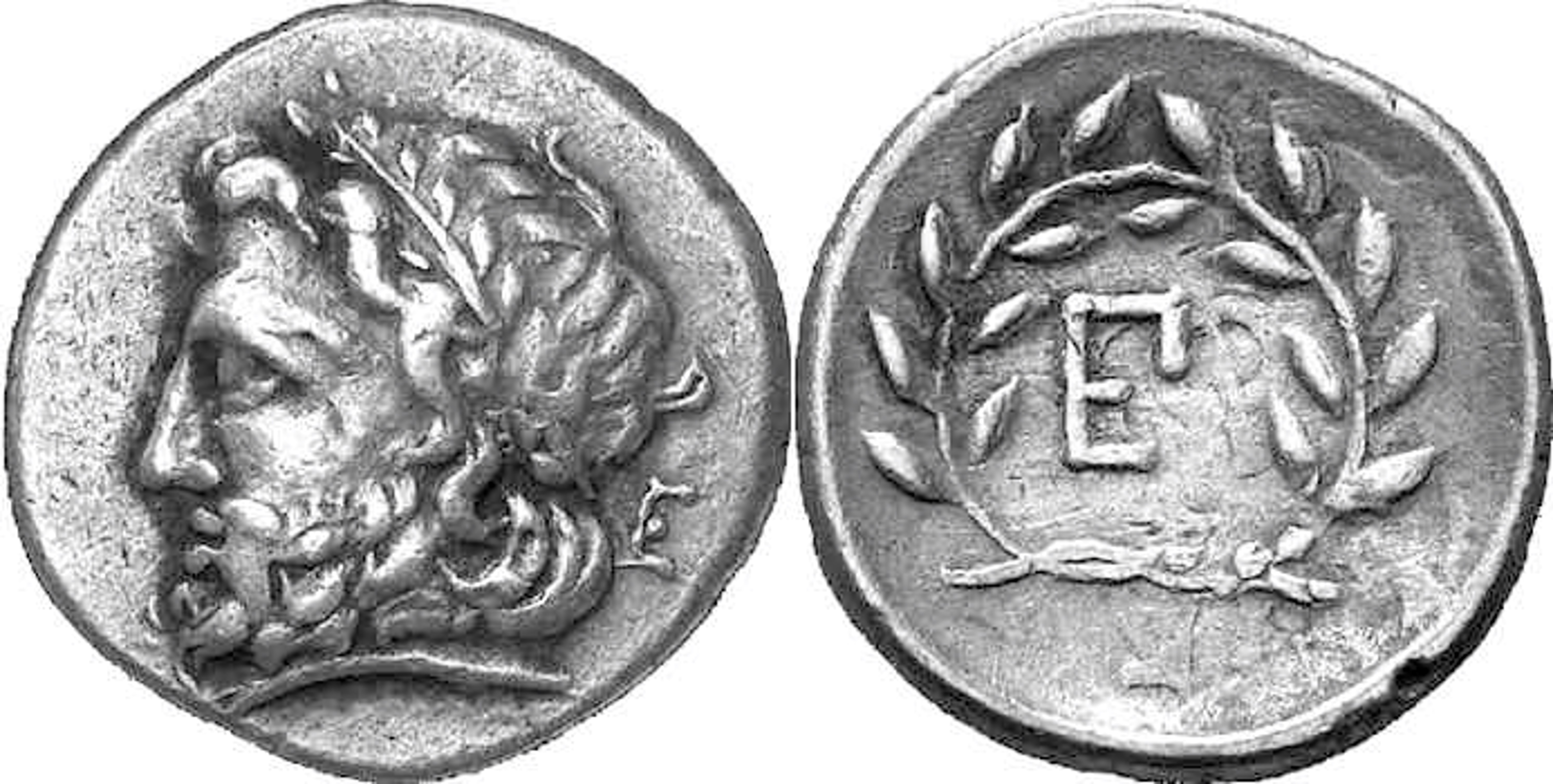3696 - Epidaurus (hemidrachm Asclepius/monogram) over Phlius (bull/phi) (BCD coll. - LHS, 96, May 2006, 1238): Difference between revisions
From SILVER
No edit summary |
No edit summary |
||
| Line 15: | Line 15: | ||
|Denomination=Hemidrachm or triobol | |Denomination=Hemidrachm or triobol | ||
|Standard=Aeginetic | |Standard=Aeginetic | ||
|Coin reference= | |Coin reference=Requier 1993, series 3 [2], D1/R1, 171. | ||
|Coin series reference=LHS 96 2006, no. 1237-1239 and 1241; Hoover 2011, no. 724 | |Coin series reference=LHS 96 2006, no. 1237-1239 and 1241; Hoover 2011, no. 724 | ||
|Overstruck reverse legend=Φ | |Overstruck reverse legend=Φ | ||
Revision as of 06:50, 26 August 2022
255 - 250 | monogram (EΠ)
Location/history
| Sale(s)Sale(s) ᵖ: | Classical Numismatic Group (23/05/2007), no. 320 ; LHS 96 (8/05/2006), no. 1238. | |
Overstriking coin
Description
| ObverseInscription or printing placed on the obverse.: | Head of Asclepius left, wearing laurel wreath. In field, E. | ReverseInscription or printing placed on the reverse.: | monogram (EΠ) Monogram within laurel wreath. |
Mint and issuing power
| MintIdentifies the place of manufacture or issue of a numismatic object.: | Epidaurus | Ancient regionAncient region. | Peloponnesus (Argolis) | Modern countryModern country: Greece | AuthorityIdentifies the issuing power. The authority can be "pretended" when the name or the portrait of X is on the coin but he/she was not the issuing power. It can also be "uncertain" when there is no mention of X on the coin but he/she was the issuing power according to the historical sources: |
Chronology
| FromIdentifies the initial date in a range assigned in a numismatic context. 255 toIdentifies the final date in a range assigned in a numismatic context.. 250 | Hellenistic 323-30 BC |
Physical description
| MetalThe physical material (usually metal) from which an object is made.: Silver |
WeightWeight of the numismatic object (in grams). in grams: 2.732.73 g <br />2,730 mg <br /> | DenominationTerm indicating the value of a numismatic object. Examples: tetradrachm, chalkous, denarius.: Hemidrachm or triobol | AxisDescribes the directional relationship between the obverse and reverse of a numismatic object.: 5 h"h" is not declared as a valid unit of measurement for this property. |
| StandardStandard.: Aeginetic | |||
References
| Coin referenceReference of the Coin: | Requier 1993, series 3 [2], D1/R1, 171. | Coin series referenceReference to coin series study: | LHS 96 20061LHS 96 2006, no. 1237-1239 and 1241, Hoover 20112Hoover 2011, no. 724 |
Overstruck type
Description
| ObverseInscription or printing placed on the obverse.: | ReverseInscription or printing placed on the reverse.: | Φ Φ within wreath. |
Mint and issuing power
| MintIdentifies the place of manufacture or issue of a numismatic object. ᵖ: | Phlius | Ancient regionAncient region. ᵖ | Peloponnesus (Phliasia) | Modern countryModern country: Greece | AuthorityIdentifies the authority in whose name (explicitly or implicitly) a numismatic object was issued. ᵖ: |
Chronology
| FromIdentifies the initial date in a range assigned in a numismatic context. toIdentifies the final date in a range assigned in a numismatic context.. | periodTime period of the numismatic object. |
Physical description
| DenominationTerm indicating the value of a numismatic object. Examples: tetradrachm, chalkous, denarius. ᵖ: | hemidrachm |
References
| Coin type referenceReference to coin series study ᵖ: | BCD Peloponnesos 132ff3BCD Peloponnesos 132ff |
Additional data
| Frequency of overstrikesFrequency of overstrikes: | Level of confidenceLevel of confidence of the identification: | ||
| RemarksRemarks: | |||
